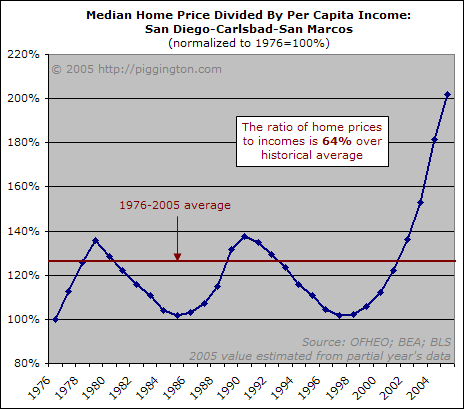This Voice of San Diego housing prediction roundup, along with a commenter’s question on the topic, has motivated me to write about forecasting, vis-à-vis whether it is is a complete waste of time. And the answer is: yes. Or no. Or, it depends, I guess.
Alright, let me start from the start, using a familiar graph as a jumping point:

Here’s what I can say with some authority: that the ratio of home prices to incomes is likely to drop by at least 50%. I can say that with some confidence because, as I’ve excruciatingly outlined in the article entitled Evidence of a California Housing Bubble, there has been no secular change in the fundamentals that would justify the home price to income ratio rising on a permanent basis. Lacking a long-term, structural shift in fundamentals, and understanding the historical behavior of financial markets, it is very likely that the ratio will decline to, and overshoot, the mean.
However,
neither I nor anyone else can with any authority forecast how much of the ratio’s decline will be caused by rising incomes versus how much will be caused by falling home prices. Furthermore, other than noting the fact that prior corrections (after dissimilar runups) to the local housing market have taken around 5 years, one cannot predict how long it will take for the adjustment to play out.
It is specifically somewhat futile to predict how much nominal home prices will rise or fall within a given number of years. Doing so requires making assumptions about exogenous factors such as the local economy or the entirely-unpredictable credit markets. Such forecasts are nothing more than guesses—educated guesses, mind you, but guesses nonetheless.
That said, there is some value in forecasting short-term market direction, on the scale of a few months. This is because one can look at specific market data and can form a picture of whether the market is strengthening or weakening, and by how much.
In short, while one can predict short-term market direction or long-term reversion to fundamentals, anything in between is pretty much guesswork, and should be viewed accordingly.

Professor–If you shoot a
Professor–If you shoot a bullet straight up into the air it slows to a stop at the apex before returning to earth. For a very brief moment there is precious little trend data to plot the bullet’s course. That is where we are now. Once the bullet begins its descent the trend data will come very quickly. Gravity always wins.
Okay, I give up. What does exogenous mean? Take it easy on your lowly readers. :-))
But what about that “soft
But what about that “soft landing” I keep hearing all the “experts” talking about???
This soft landing idea, that prices will just hang where they are, not rising or falling, or even rising along with inflation, is riduculous. So prices more than double over the last 5 years for no fundamentally based reason, and we are expected to accept that they will now just revert back to normal appreciation?
In order for the ratio of home prices to incomes to drop by at least 50%, as you state (which I totally agree with), wages will have to grow considerably – and it will probably take 15 to 20 years! I don’t see that happening. We (the U.S.) are increasingly competing with the rest of the world for jobs now. I see our overall standard of living decreasing over time. Here’s my worthless prediction: home prices in San Diego will fall significantly farther to meet wages than wages will rise to meet home prices.